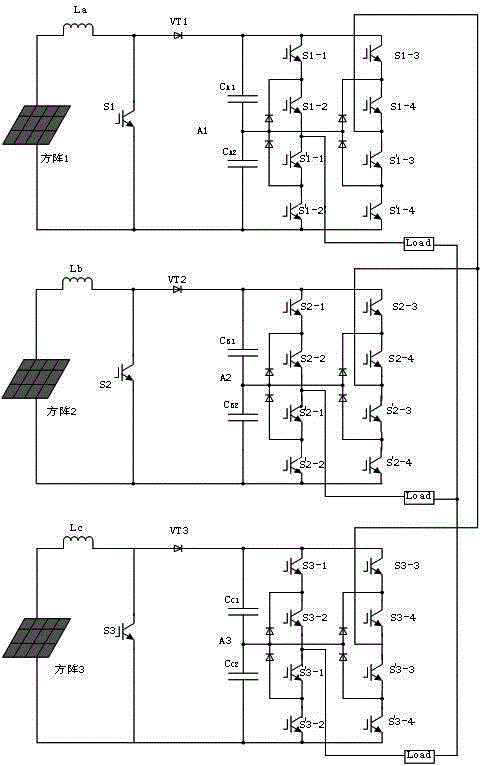Suppression method for neutral point voltage imbalance of five-level inverter
A neutral point voltage and inverter technology, applied in the direction of irreversible DC power input conversion to AC power output, electrical components, output power conversion devices, etc., can solve power supply short circuit, capacitor voltage imbalance, circuit cost increase and other issues, to achieve the overall efficiency improvement, simple control scheme, and reduce coupling effects
- Summary
- Abstract
- Description
- Claims
- Application Information
AI Technical Summary
Problems solved by technology
Method used
Image
Examples
Embodiment 1
[0021] Such as figure 1As shown, the suppression method in the A phase is: when the capacitors CA1 and CA2 are in different working states, the voltages at both ends of CA1 and CA2 will be different, thus causing the voltage at point A1 to be not 1 / 2 of the DC side Voltage, causing the neutral point potential of the inverter output voltage to be non-zero, ensuring that the voltage at point A1 is maintained at 1 / 2 of the DC side voltage is the main measure to eliminate the neutral point potential shift of the output voltage, as follows:
[0022] When working in the positive half cycle, when the voltage across the capacitor CA1 is higher than the voltage across the capacitor CA2 at a certain moment, the switching tubes S1-1, S1-2, S1-4 and -3 is turned on, because the capacitor CA1 is connected to the load, and the voltage at both ends of the circuit will decrease, and at the same time, the capacitor CA2 will be charged, and the voltage on it will increase until the voltage at ...
Embodiment 2
[0025] Such as figure 1 As shown, the suppression method in the B phase is: when the capacitors CB1 and CB2 are in different working states, the voltages at both ends of CB1 and CB2 will be different, thus causing the voltage at point B1 to be not 1 / 2 of the DC side Voltage, causing the neutral point potential of the inverter output voltage to be non-zero, ensuring that the voltage at point B1 is maintained at 1 / 2 of the DC side voltage is the main measure to eliminate the neutral point potential shift of the output voltage, as follows:
[0026] When working in the positive half cycle, when the voltage across the capacitor CB1 is higher than the voltage across the capacitor CB2 at a certain moment, the switching tubes S2-1, S2-2, S2-4 and -3 is turned on, because the capacitor CB1 is connected to the load, and the voltage at both ends of the circuit will decrease, and the capacitor CB2 will charge at the same time, and the voltage on it will increase until the voltage at both...
Embodiment 3
[0029] Such as figure 1 As shown, the suppression method in the C phase is: when the capacitors CC1 and CC2 are in different working states, the voltages at both ends of CC1 and CC2 will be different, thus causing the voltage at C1 to be not 1 / 2 of the DC side Voltage, causing the neutral point potential of the inverter output voltage to be non-zero, ensuring that the voltage at point C1 is maintained at 1 / 2 of the DC side voltage is the main measure to eliminate the neutral point potential shift of the output voltage, as follows:
[0030] When working in the positive half cycle, when the voltage across the capacitor CC1 is higher than the voltage across the capacitor CC2 at a certain moment, the switching tubes S3-1, S3-2, S3-4 and -3 is turned on, because the capacitor CC1 is connected to the load, and the voltage at both ends of the circuit will decrease, and the capacitor CC2 will charge at the same time, and the voltage on it will increase until the voltage at both ends ...
PUM
 Login to View More
Login to View More Abstract
Description
Claims
Application Information
 Login to View More
Login to View More - Generate Ideas
- Intellectual Property
- Life Sciences
- Materials
- Tech Scout
- Unparalleled Data Quality
- Higher Quality Content
- 60% Fewer Hallucinations
Browse by: Latest US Patents, China's latest patents, Technical Efficacy Thesaurus, Application Domain, Technology Topic, Popular Technical Reports.
© 2025 PatSnap. All rights reserved.Legal|Privacy policy|Modern Slavery Act Transparency Statement|Sitemap|About US| Contact US: help@patsnap.com

